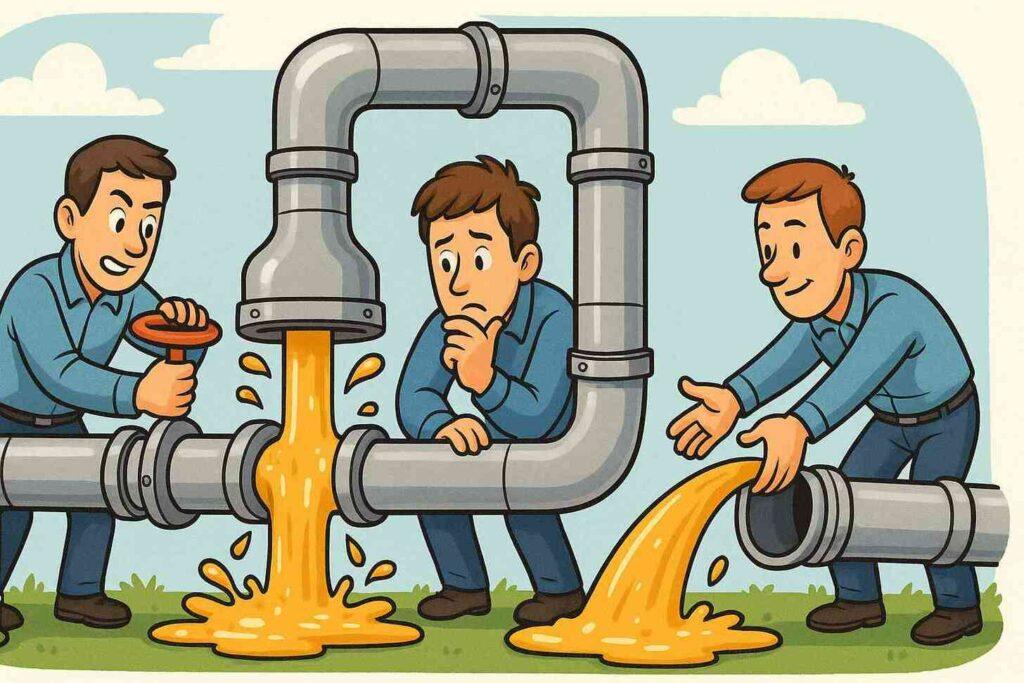Ever feel like you’re working harder but not moving forward? The theory of constraints mental model was created by physicist and business thinker Eliyahu Goldratt. It finds the single biggest thing that stops you from moving forward.
It could be a slow production line, a jammed hospital system, or a hard-to-break personal habit. This model helps you see and solve the main problem. It’s like fixing a clogged drain—once the blockage is gone, everything moves smoothly again.
Developed by Eliyahu Goldratt, this method cuts through distractions. Instead of fixing every problem, it asks: “What’s the one thing limiting progress right now?” Imagine a traffic jam—clearing side streets won’t help if the main bridge is blocked. By targeting the true constraint, you create ripple effects that boost entire systems.
Think of the theory of constraints (TOC) as a GPS for problem-solving. Most strategies spread effort thin, but this model directs you straight to the source. For example, a bakery struggling with orders might realize its oven capacity—not staff speed—is the real bottleneck. Fix that, and everything flows smoother.
Key Takeaways
- Theory of constraints mental model focuses on identifying the biggest bottleneck, not minor inefficiencies
- Treats systems as interconnected chains where one weak link defines success
- Prioritizes root-cause solutions over surface-level fixes
- Applies to manufacturing, healthcare, personal growth, and more
- Creates breakthrough results by optimizing constraints first
Whether you’re scaling a business or managing daily tasks, this mental model offers clarity. It’s not about working harder—it’s about working smarter where it counts most. Ready to find your bottleneck?
Overview of the Theory of Constraints Mental Model
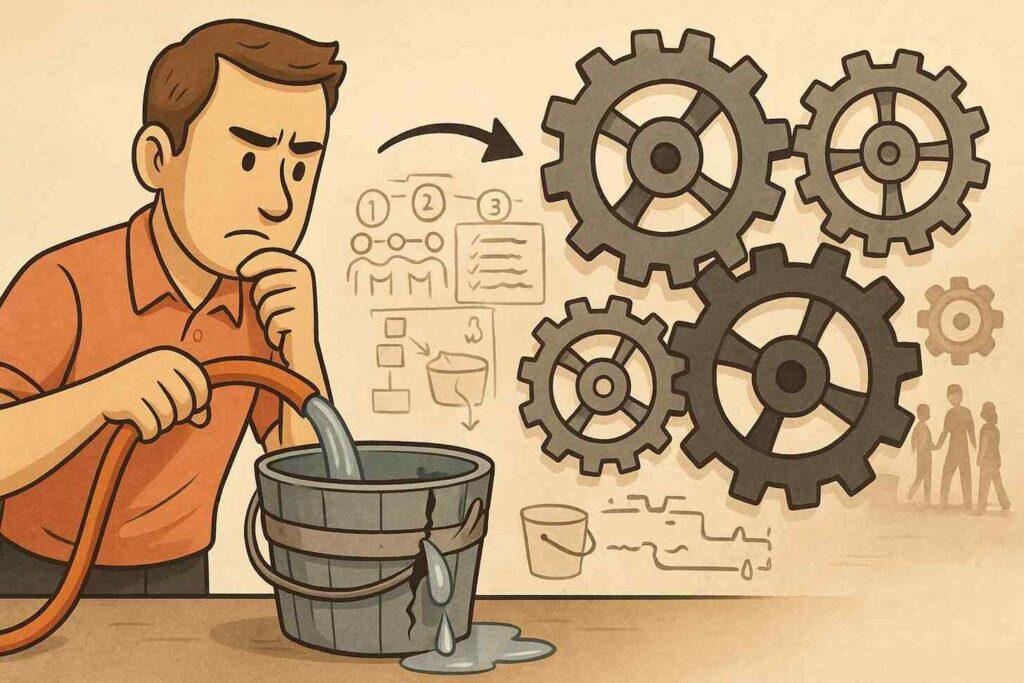
Imagine trying to fill a bucket with a hole in it. Fixing cracks near the rim won’t stop water from draining—you need to patch the main leak first. This mindset drives the method we’re exploring: it treats every organization like interconnected gears, where one stuck cog slows the entire machine.
This is a key principle of the theory of constraints mental model.
Traditional improvement plans often spread resources thin. Teams upgrade software, hire specialists, or rearrange workflows—only to see minimal gains. Why? Because they’re polishing gears that aren’t causing the jam.
This approach flips the script: Find the single point where effort creates domino effects. This way of thinking emphasizes the importance of focusing on the right processes to create meaningful change.
Think of a hospital emergency room. Adding more doctors won’t help if beds stay occupied for days. The real fix? Faster patient discharges.
By viewing the hospital as a living network, leaders spot hidden connections between departments and understand how time and resources can be better allocated to improve the overall process.
| Traditional Methods | TOC |
|---|---|
| Optimizes individual parts | Targets system-wide flow |
| Requires broad investments | Demands focused changes |
| Yields 5-10% improvements | Creates 30-50% leaps |
Three principles guide this strategy:
- Every process has one critical choke point
- Non-critical fixes drain time/money
- Small adjustments create oversized results
A shipping company learned this firsthand. Instead of buying more trucks, they redesigned loading docks. Truck idle time dropped 40%—proving that smart targeting beats brute force.
The Origin and Evolution of The TOC
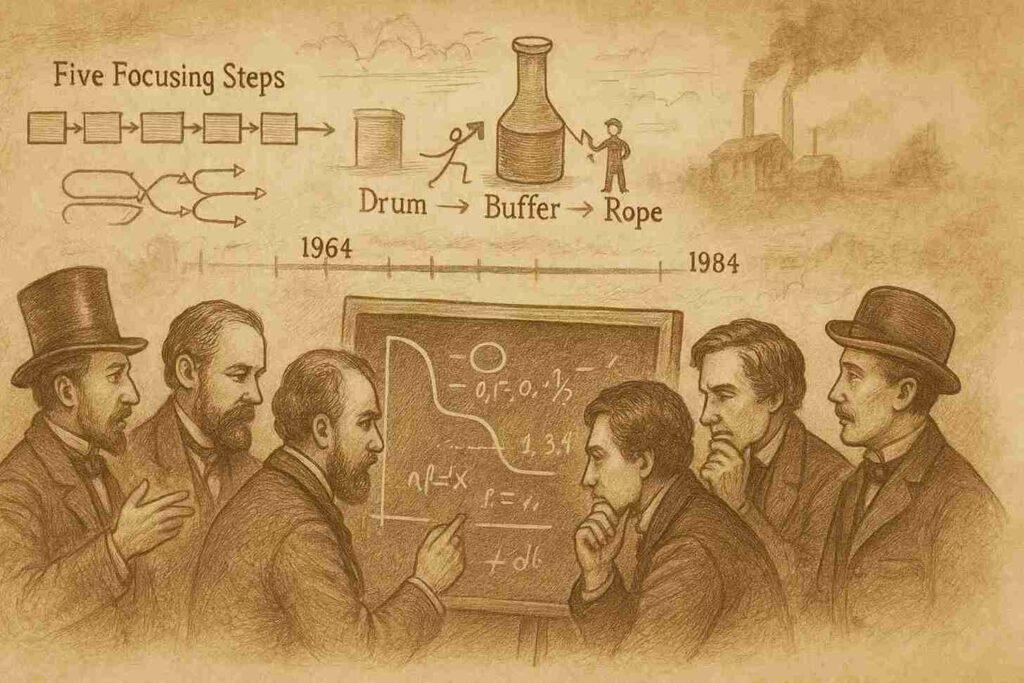
In the 1970s, a physicist watched companies struggle like rivers blocked by boulders. Dr. Eliyahu Goldratt realized that organizational hurdles weren’t about effort—they needed precise intervention.
His solution? A radical method born from observing factory floors and physics labs alike, which emphasized the theory of constraints and the way people could change their thinking about processes.
Goldratt’s 1984 novel The Goal changed everything. Unlike dry textbooks, it used storytelling to show how fixing one bottleneck could transform entire operations. Factory managers devoured its pages—finally, complex ideas felt actionable, providing a step toward a new way of thinking about system efficiency.
| 1980s Focus | Modern Applications |
|---|---|
| Assembly line efficiency | Hospital patient flow |
| Inventory management | Software development cycles |
| Machine throughput | Personal productivity systems |
Three breakthroughs fueled the theory of constraints growth:
- Flow-first thinking: Prioritizing movement of goods, data, and money
- Measurable solutions: Applying physics principles to human systems
- Adaptable framework: Scaling from factories to startups
Goldratt’s legacy lives where science meets practicality. From Fortune 500 firms to solo entrepreneurs, his body of knowledge keeps evolving. What hidden boulders might be blocking your progress?
How the Theory of Constraints Mental Model Improves Decision-Making
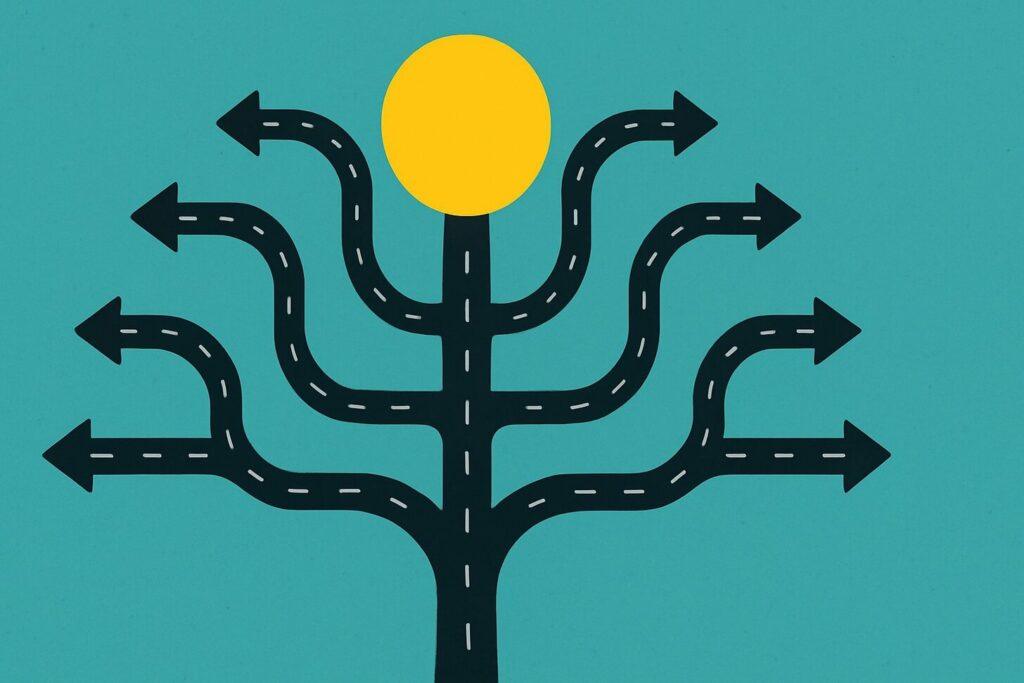
Most problem-solving methods only fix symptoms, not the real issues. The Theory of Constraints (TOC) changes this by asking: “What is the single point of failure that affects everything else?” This approach sharpens decision-making by focusing efforts and eliminating distractions.
A 2021 McKinsey survey showed that companies using TOC made decisions 32% faster than others. TOC is more than a tool; it’s a way of thinking. It helps managers turn messy data into clear priorities using the Five Focusing Steps. This way, they can tackle problems at their source, not just react to symptoms.
Understanding System Constraints in Business Operations
Why do some business fixes create new problems elsewhere? Picture traffic lights versus road construction—one causes temporary slowdowns, the other reshapes entire routes.
This distinction lies at the heart of managing system limitations effectively, as it reflects the theory of constraints and a way of thinking about process improvement.
The goal is to ensure that changes made by people in one part of the system do not negatively impact other areas, leading to better performance and ideas for continuous improvement.
Differences Between Bottlenecks and Constraints
Bottlenecks are like rush-hour traffic—annoying but temporary. Constraints act as permanent chokepoints defining your entire operation’s capacity. A hotel chain learned this when adding front-desk staff didn’t reduce check-in lines. The real issue? Their reservation software couldn’t handle peak demand.
| Aspect | Bottleneck | Constraint |
|---|---|---|
| Duration | Temporary blockage | Strategic leverage point |
| Impact | Slows specific steps | Governs total output |
| Solution | Quick capacity boost | System redesign |
Theory of Constraints Mental Model Across Industries
A Midwest manufacturer thought their packaging line was the problem. After analysis, they discovered raw material storage limits caused 73% of delays. By reorganizing their warehouse—not buying faster machines—they boosted output by 41%.
Service businesses face different hurdles. A tech support team kept missing response targets. The constraint? An outdated ticket routing process creating artificial bottlenecks. Streamlining approval steps reduced resolution time by 28% without hiring extra staff.
Three signs you’ve found a true constraint:
- Work piles up consistently in one area
- Expedited requests become standard practice
- Multiple departments adjust their pace to match it
What’s holding back your progress—a temporary jam or a strategic pivot point?
Mental Models That Complement TOC
TOC doesn’t work alone—it goes great with other mental models. Systems Thinking, for instance, looks at feedback loops and delayed effects. This matches well with TOC’s focus on cause and effect.
Occam’s Razor also helps by stopping teams from making things too complicated. It keeps things simple when finding constraints.
The Pareto Principle (80/20 Rule) is another great partner. It shows that most outcomes come from a small part of the system. This supports TOC’s idea that focusing on key areas can lead to big improvements.
Together, these models make diagnosing problems easier. They help teams focus their efforts on the most important areas.
Common Misconceptions About Constraints

Many people think constraints are just limits or weaknesses. But in TOC, they’re seen as chances for growth. By focusing on the one step that holds things back, the TOC mental model guides leaders to improve with purpose. Yet, myths about this idea remain.
Teams often think constraints are always about machines or equipment. But, they can also be about rules, culture, or even our own minds. A 2018 study by the Journal of Operations Management showed that over 47% of what people thought were constraints were actually just mistakes in understanding.
TOC in Healthcare: Reducing Patient Wait Times

Imagine rushing to the ER only to wait hours for care—what if the solution wasn’t more staff but smarter resource alignment?
A groundbreaking 2010 study revealed how hospitals achieved dramatic improvements by tackling one overlooked factor, understanding the theory of constraints as an opportunity to make better decisions and enhance the value of their services.
Impact of Bed Availability on Flow
Emergency departments often focus on triage speed or doctor availability. But researchers discovered patients spent 37% longer in waiting areas when beds stayed occupied. Like traffic backing up at a tollbooth, every delay rippled through the system.
Insights from the 2010 Emergency Department Study
The study compared two hospitals over six months. One added nurses and upgraded equipment. The other focused solely on bed turnover rates. The results shocked administrators:
| Traditional Approach | TOC Strategy |
|---|---|
| Hired 15% more staff | Redesigned discharge protocols |
| Bought new monitoring devices | Tracked bed availability in real-time |
| 28% cost increase | 19% cost reduction |
By prioritizing bed availability, the second hospital cut wait time by 30%. Staff morale improved as overcrowding decreased. Patients received care faster without costly expansions.
This approach works beyond ERs. Surgery centers using similar methods reduced prep time by 22%. Outpatient clinics streamlined check-ins when they stopped fixing non-critical issues first.
What invisible bottleneck might be slowing your progress right now?
TOC in Manufacturing: Maximize Throughput

What if upgrading machines isn’t the answer to faster production? Many factories discover their real growth lever isn’t new equipment—it’s smarter use of existing tools. Like fixing traffic lights instead of building extra lanes, this strategy unlocks hidden capacity in surprising places.
Optimizing Bottleneck Machines
One automotive parts maker faced a puzzle. Their $2 million press produced gears slower than cheaper machines down the line. Instead of replacing it, they analyzed its process. Simple maintenance and shift scheduling adjustments boosted output by 34% in 11 days.
| Traditional Approach | Focused Strategy |
|---|---|
| Upgrades all equipment | Targets one critical machine |
| 5-8% annual gains | 20-50% rapid improvements |
| High capital costs | Low-cost adjustments |
Achieving 20-50% Productivity Gains
A textile company tripled profits without buying looms. Their constraint? Fabric dyeing time. By reorganizing workflow sequences, they reduced idle periods by 47%. This created ripple effects across shipping and inventory management.
Three patterns emerge in successful implementations:
- Precise identification of the machine governing total capacity
- Cross-training teams to support constraint operations
- Real-time monitoring of bottleneck performance
These methods prove that benefits of applying focused problem-solving methods extend beyond factories. When you fix the gear that sets the pace, entire systems synchronize naturally. Could your process improvements be targeting the wrong cog?
Supply Chain Improvements Through TOC
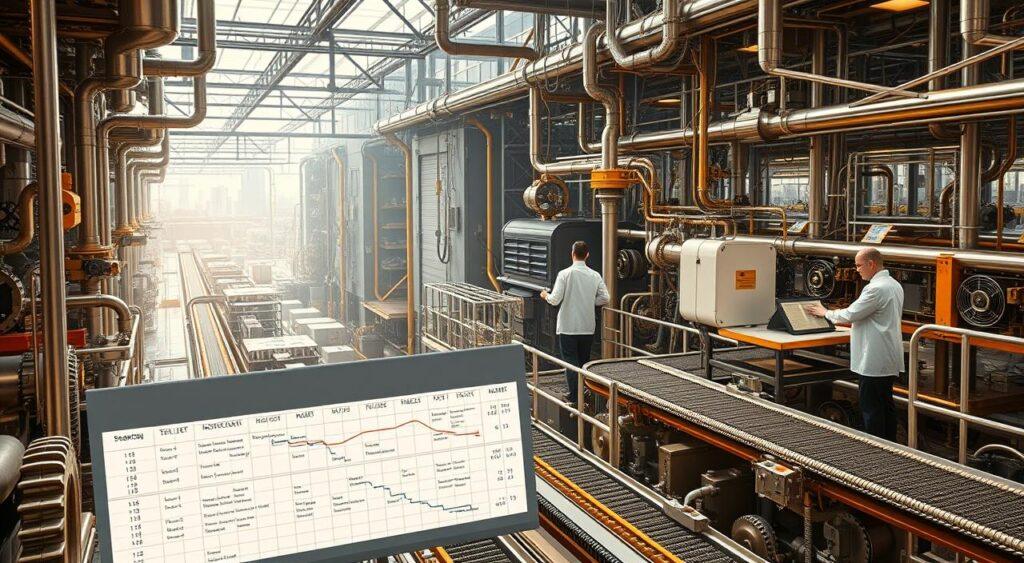
Indian manufacturers faced a delivery crisis—until one method transformed their operations. A 2022 study revealed how 47 companies slashed late shipments by 44% using focused scheduling tactics. This breakthrough came not from new technology, but from aligning existing resources around key choke points.
Enhancing On-Time Delivery Rates
Traditional scheduling often creates invisible roadblocks. Teams would optimize individual warehouses or trucks, missing the bigger picture. The real issue? Coordination gaps between production cycles and delivery windows.
| Traditional Scheduling | TOC-Based Approach |
|---|---|
| Focuses on local efficiency | Aligns entire network flow |
| Reacts to daily disruptions | Predicts constraint impacts |
| 38% average on-time rate | 82% post-implementation |
Researchers found most delays stemmed from mismatched timelines. Raw materials arrived early, but assembly lines waited for components. By syncing these processes, companies reduced idle time by 51%.
The solution required three shifts:
- Mapping the entire supply network as interconnected nodes
- Identifying two critical handoff points governing total cycle time
- Creating buffer stocks before constraint operations
One auto parts supplier achieved 94% on-time rates within six weeks—their best results in a decade. This supply chain methodology proves that targeted improvement beats blanket upgrades.
Could realigning your schedules around key nodes unlock similar gains?
The Five Focusing Steps of The TOC
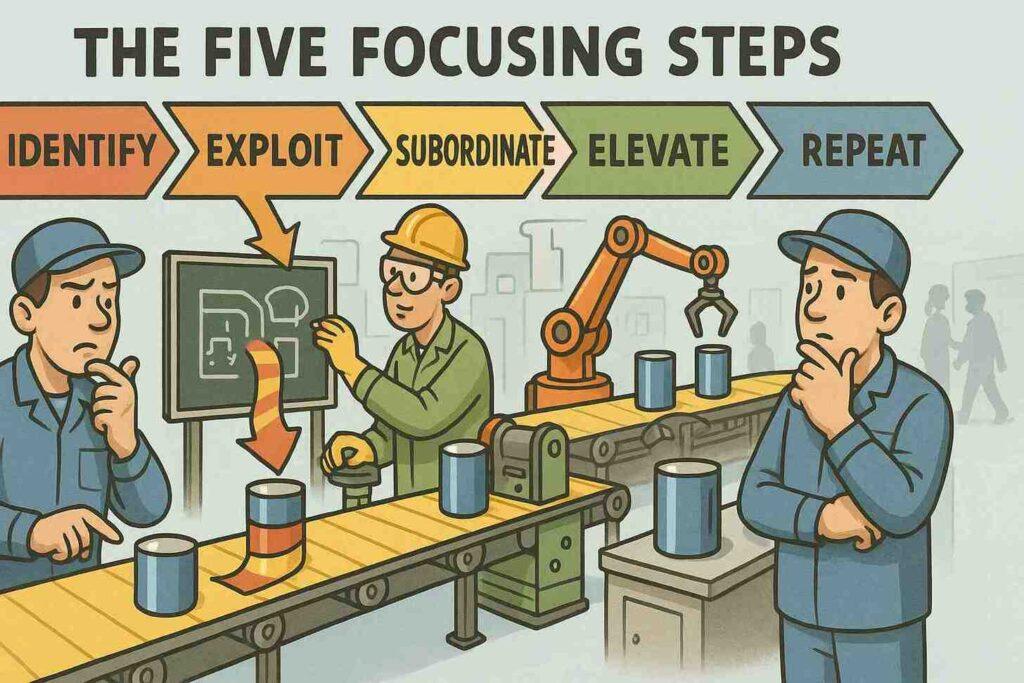
Ever tried navigating a maze blindfolded? This method gives you five clear handholds to find your way out.
It’s not about overhauling everything—just smart adjustments where they matter most, reflecting the theory of constraints and the reality of performance change. Each step involves people sharing ideas for improvement to achieve a common goal.
Identify and Exploit the Constraint
Spotting the real issue feels like finding a hidden switch. Look where work piles up or delays become routine. A delivery company discovered their sorting hub—not trucks—was slowing orders. Quick fixes like staggered shifts boosted daily shipments by 19%.
Subordinate, Elevate, and Repeat
Once you’ve fixed the main roadblock, align other steps to support it. A software team reduced bug reports by 40% when they matched testing schedules to developer output. If the constraint shifts, adapt your focus—growth never stops.
Three patterns emerge in successful implementations:
- Prioritize quick wins over perfect solutions
- Measure how changes affect overall flow
- Treat each solved problem as a new starting point
This approach turns chaos into rhythm. What’s your next bottleneck?
Conclusion
The theory of constraints mental model isn’t just for factories or spreadsheets—it’s a mindset for anyone trying to do more with less. It helps you see the one thing that holds you back. Finding and fixing this core constraint can make progress feel almost effortless.
Whether you manage a supply chain or a to-do list, this model helps you stop spinning your wheels. It helps you start creating real flow.
